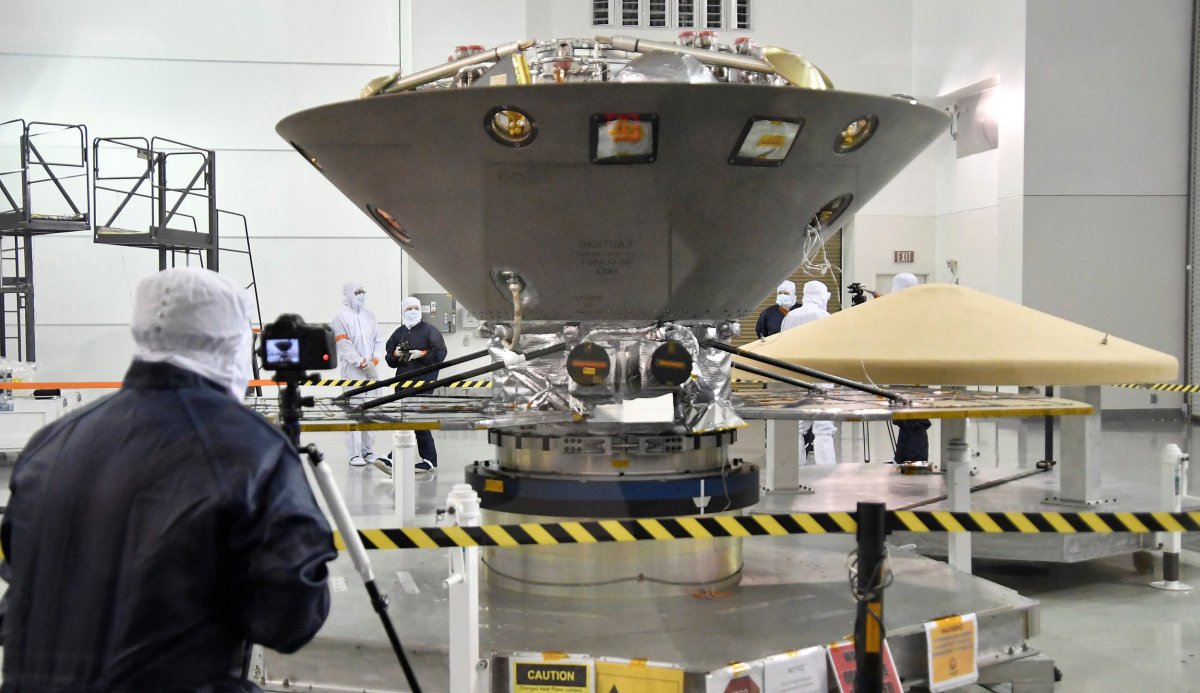For all the stunning photos we have of the surface of Mars, its depths are an enigma. Scientists have some theories about what's hiding below, but, beginning with the first successful landing, in 1975, none of the missions that have touched down on our neighbor's surface have looked past the topmost layer of soil.
NASA's Mars InSight mission, scheduled to launch on Saturday, aims to change that. It's armed with just a couple of instruments and can't move about the surface. But scientists have been scheming to make the mission a reality for decades, and they're confident it's up to the challenge.
"It's been 30 years of frustration and 10 years of getting ready to go to Mars," InSight Principal Investigator William "Bruce" Banerdt, a planetary scientist at NASA, told Newsweek.
Beyond the field of planetary science, InSight has created much less excitement than NASA's most recent rover mission, Curiosity. "Geophysics missions take a little bit more discussion and a bit longer story, perhaps, to explain," InSight Deputy Principal Investigator Suzanne Smrekar, a planetary scientist at NASA's Jet Propulsion Laboratory, told Newsweek.
Smrekar called the project a "time machine" for Mars, targeted at understanding the planet's first few tens of millions of years.
Read more: NASA launching spacecraft to another planet from California for the first time
Perhaps her favorite of InSight's instruments is the planetary equivalent of taking a patient's temperature beneath their tongue. It's essentially a glorified thermometer that can drill itself into the rock, squeezing the soil it displaces out to the side. "It's basically like a self-hammering nail; it's kind of like a jackhammer," Smrekar explained.
The instrument will help scientists track how heat moves through the planet. As planets age, their innards generally cool, but a few elements, like uranium and potassium, release small amounts of heat as they radioactively decay over time. That heat can add up, and on Mars, scientists think most of those elements are found in the crust. Using the heat probe to determine whether that's true will help scientists gauge the accuracy of their theories about how Mars formed.
Smrekar has been chasing the idea for more than two decades, after she decided one morning in the shower that she wanted to build planetary heat probes.
Another key mystery the surface of Mars hides is the planet's interior structure: how thick its core, mantle and crust are. Banerdt said he has waited decades to finish up some of his earliest research, which he needed the thickness of the crust to complete.
"It was frustrating," he said, especially when the Viking mission failed its quest to make the measurement. "That kind of went into the file drawer for a while."
InSight's seismometer, which will measure the waves of energy produced by Marsquakes, should finally produce the number Banerdt has been waiting for. That device will mimic what huge networks of seismometers on Earth have done to map the interior of the planet based on waves behaving differently as they move through different types of rock. The device is so sensitive that its measurements are affected by the wind, so the lander is also equipped with a weather station to let scientists remove that influence from their data.
InSight also is planning to measure the size of the planet's innermost core. To do so, scientists will use incredibly precise measurements of the distance between Earth and the instrument—precise enough to pinpoint the location to within just six inches. "To me, that's mind-boggling, as close to magic as you can get and still be science," Banerdt said.

By tracking the spacecraft's steady location as the planet spins, he and his colleagues can pinpoint the precise location of the invisible axis the planet is spinning around. "We can actually watch the North Pole wobble over the course of the year," Banerdt said. "That wobble is connected to how the core is sloshing around inside the planet."
The InSight mission is due to launch as early as Saturday morning at 7:05 EDT. It must launch before June 8 in order to make it to Mars this year; otherwise it will need to wait another 26 months.
Once it arrives, InSight should have plenty of time to accomplish its goals. It runs on solar energy, and after the heat probe is inserted, nothing on the spaceship will really be moving, so parts can't easily break or wear out. "We hope to live for a very long time," Smrekar said.
Uncommon Knowledge
Newsweek is committed to challenging conventional wisdom and finding connections in the search for common ground.
Newsweek is committed to challenging conventional wisdom and finding connections in the search for common ground.
About the writer
Meghan Bartels is a science journalist based in New York City who covers the science happening on the surface of ... Read more
To read how Newsweek uses AI as a newsroom tool, Click here.








